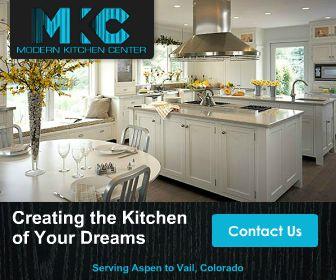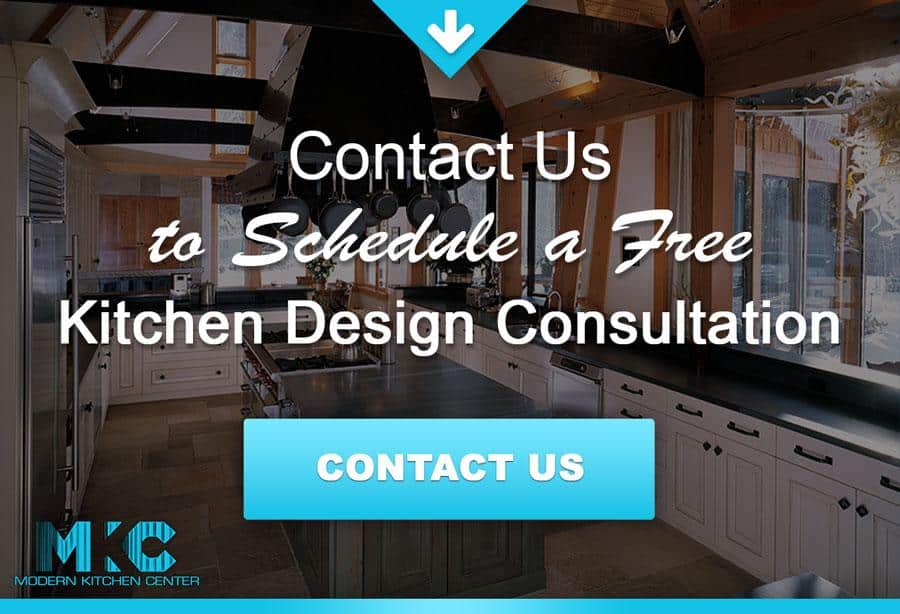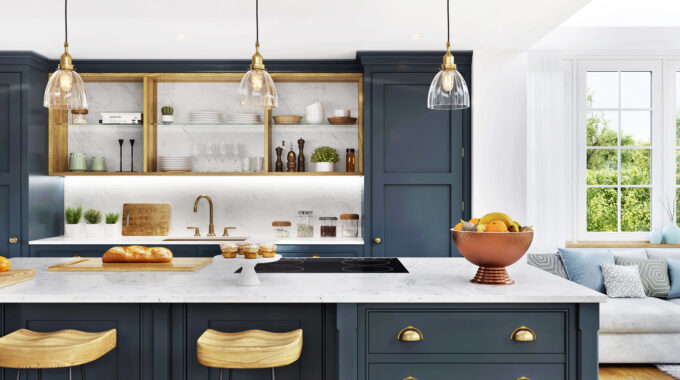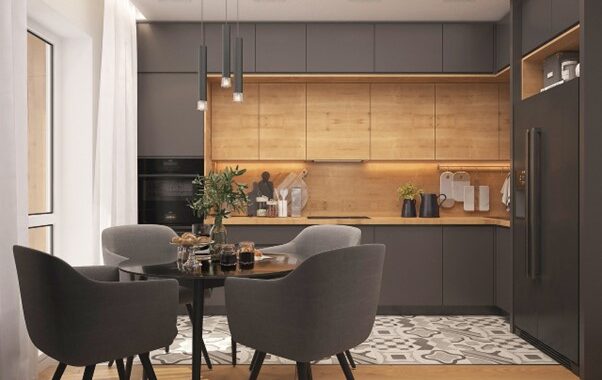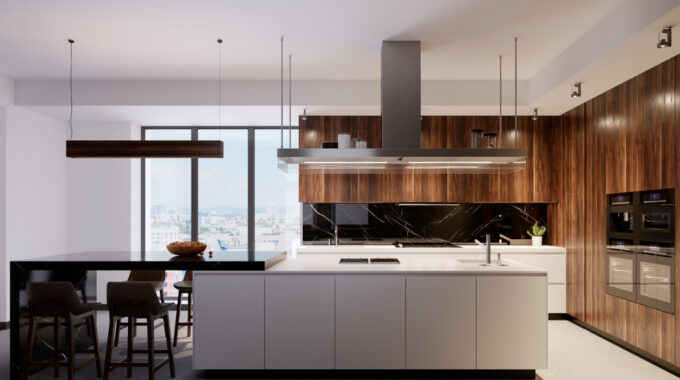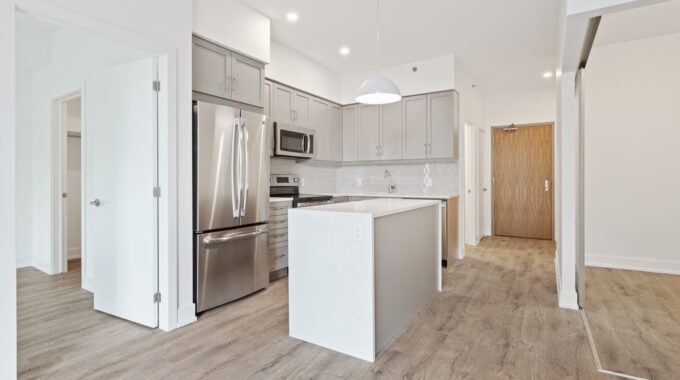
The Best Design Layout for your Kitchen Renovation Project
Your kitchen design layout is the most important contributing factor that ensures the functionality and practicality of your kitchen space. It doesn’t matter if your kitchen is tiny and cramped or you have a huge floor area that expands from one corner of the room to the other. A practical and clever layout design will bring out the most of the space you have. There are plenty of things to consider when designing your kitchen layout.
Not only do you have to think about where your cabinets and furniture will go, but a special focus must be given to the height of kitchen counters and the island. You must also try to ensure that there is enough free space for easy movement and designated areas for various kitchen appliances.
In this article, we will be going over kitchen ergonomics, the principles of the kitchen work triangle, and different design layouts that optimize the workflow in a given area.
Kitchen Ergonomics and the Work Triangle
Kitchen ergonomics builds the foundation of a stellar kitchen design. Ergonomics is the science of creating and designing an environment that is tailored to the people using them, as opposed to people adapting to fit the environment. Kitchen ergonomics lead the efficiency and accessibility in the given space. The work triangle was coined in the 1920s as one of the first frameworks of enhancing efficiency in a residential kitchen.
The triangle consists of a clear path between three main points or workstations that forms a functional kitchen. You have the stovetop where you prepare your food, the cleaning station where the sink is placed, and the area where food is stored, i.e., the refrigerator or pantry.
Principles of the Kitchen Work Triangle
- The standard length of all the triangle legs should be between 1.2 to 2.7 meters.
- The cumulative length of all three legs should be between 4 to 7.9 meters.
- Make sure that none of the cabinetry or appliances are standing in the way of the legs of the triangle.
- The path between the work triangle should be clear and free of any major traffic.
To maximize the efficiency and workflow of the kitchen, here are a few guidelines that you may follow:
- The entry doorway which goes into the kitchen should be a minimum of 812mm wide.
- Make sure that the entryway or kitchen door gets in the way of any of the appliances. Pay close attention to appliances doors and make sure they don’t get in each other’s way
- The length of the countertops should be at least 1060mm for a single cook, and at least 1220mm for multiple cook kitchen
- The walkways must at least have a width of 915mm.
- If you only have one sink in the kitchen, then locate it across from the refrigerator and stovetop.
- The workspace next to the sink should have a minimum width of 760mm with 600mm depth.
- The sink should be installed with a landing area of at least 610mm with 460mm on both sides.
- If you plan on installing a dishwasher, then position it within 900mm from the sink.
- The cooking station must have a landing area of 300mm on one side and 380mm on the other.
- A landing space is required at a distance of at least 380mm from the handle side of the fridge, or it could be opposite the fridge within the 1200mm range.
- A minimum of 600mm space is required between the cooking area and the non-combustible surfaces above it.
- Install a ventilation system above the primary cooking appliances, that includes the stovetop, the oven, and in some cases, the microwave too.
- It is against kitchen guidelines to locate the cooking surface under a window that can be opened and closed. Locate the fire extinguisher near the kitchen exit, away from all the cooking equipment.
- Place your microwave ovens based on your requirements – the ideal place for a microwave is 75mm below your shoulder height.
- A landing area of at least 380mm above or below the microwave should be provided
- 4000mm of total countertop space with a depth of 600mm and height of 380mm is required to provide the ideal storage and workspace required for cooking, preparation, and landing surfaces.
- Apart from the general lighting of the kitchen, each workstation should be appropriately lit by task lighting.
Things to Consider in your Kitchen Design Layout
If you’re planning on renovating your kitchen, there are a number of different layout designs that you have to keep in mind when you are in the planning stages. The secret to a good kitchen has little to do with the way it looks and everything to do with its functionality and usage.
Here is a list of kitchen design layouts that you can include in your kitchen:
Reduced Traffic
Regardless of the number of people living in the house, the kitchen is the heart of the home, and it is inevitable that it is going to be a high-traffic area of the house. There are a number of ways in which you can transform your kitchen into an area where there are separated spaces for mails, coats, and backpacks. You can plan on incorporating a mudroom before the kitchen to control the traffic that flows through every day. The primary pathway which leads to the kitchen should be hazard-free and should not be disrupted by the refrigerator’s door when open. Create zones for easy access to different stations and workspaces.
Keep Appropriate Distance between Main Fixtures
The main tasks in the kitchen consist of preparing food, serving, and cleaning up after meals. Your kitchen layout should be designed in a way that the main fixtures, such as the stove, sink, and fridge, should be placed near one another. You don’t want your stove too far away from the fridge or the sink since it will become an inconvenience while doing a certain task. Your main kitchen appliances should be placed in close proximity for improved efficiency.
Placement of the Kitchen Island is Key
The kitchen island is the place where most of the food preparation takes place, and by adding a few bar stools, it’s the central spot to have family discussions and keep an eye on the kids while they do their homework. Decide carefully where you want to place your island. It’s essential that it does not block any of the appliances such as the refrigerator, dishwasher, and wall ovens. There should be enough space that you can easily walk across when the doors of any of the appliances are open. You also don’t want your island to be so far away that you must take a few extra steps to walk over to each appliance.
Install the Sink First
Most of the time, designers place the sink first and then design the rest of the kitchen around it. This practice stems from tradition back when people spent a lot of time scrubbing and washing dishes. The method has carried on, and it is a good rule of thumb for designers. While the oven and stovetop is where you prepare your meal, the area near the sink is more likely to be the place where you spend most of your time. When deciding the location of your sink, place it where you can either look out the window or into the rest of the room. Placing the sink on the island is also a good option for people that have limited floor space for the kitchen.
Fit the Stove on an Exterior Wall
When it comes to deciding the location of your stove, the standard way is to put it on an exterior wall. Placing the stove on the island or on an interior wall will make it inconvenient and expensive to install a ventilation system. Placing the stove and oven on the exterior wall will give more countertop space and an easy way to fix the ventilation system.
Consider Vertical Walled Storage
Most people make the mistake of putting in a lot of effort to create enough cabinets and drawers for storage. Instead, try to go for wall storage that can store your pantry goods, small electrical appliances, baking equipment and accessories, and even extra crockery and China. Opting for open shelves and overhead pot racks adds convenience and an aesthetic appeal to your kitchen.
Different Types of Kitchen Layouts
Now that we know all the things we should consider when planning our kitchen layout. Let’s take a look at the best kitchen designs and layouts:
One-Walled Kitchen
This is found in relatively smaller kitchens and is simple and efficient. The cabinets are installed on a single wall, consisting of upper and lower cabinetry and shelving to create a fine aesthetic. When working with a single wall, it’s important to think vertical in terms of storage space, so take your cabinets as high up as possible. Creating a work triangle can be difficult with a single wall, but you can place your fridge on one end of the kitchen, stove in the middle, and the other end can have the sink.
Galley Kitchen
This is the most efficient way of using cabinetry – installing them in rows of two, face-to-face each other, and creating a small pathway or galley between them. This layout uses every millimeter of floor area without wasting any negative space.
L-Shaped Kitchen
This practical layout can be used for large and small kitchens that have cabinets installed along two perpendicular walls. This open plan design of the L-shaped kitchen brings flexibility and choice for dedicating space for appliances and work zones. You can even choose to install a walk-in pantry in the corner of your kitchen without losing out on valuable space.
U-Shaped Kitchen
This layout is perfect for kitchens with large open space. The cabinetry is placed along three adjacent walls providing plenty of storage space. To prevent the kitchen from feeling too enclosed, ditch the upper cabinetry from one of the walls. You can even opt for open shelves and focal tiles for a more modern look. The u-shaped kitchen allows multiple people to work at once, and it comes with a smooth workflow.
See also: A Guide to Kitchen Cabinetry Inspiration
The Peninsula Kitchen
The peninsula includes an island in the kitchen and a counter that is an extension of the wall or cabinetry. This layout design is incorporated in a way that you won’t have the need to install a separate island, but you still get the same benefits and functionality of having one. The peninsula can be used to prepare food, to have a meal, or you can use it to perform other tasks while you wait for your food to finish cooking.
The Bottom Line
Kitchen renovation can be a major task to undertake, and it’s not the cheapest project to fund either. To get the most from your kitchen and to suit all your needs, it’s important to understand the foundations of building a functional kitchen. Emphasis on the work triangle should be the top priority as it contains the main fixtures of the kitchen. Once you have your foundation, you can begin choosing the type of kitchen design layout you want.
Give Modern Kitchen Center a call and let’s get your kitchen layout designed to best fit your home and lifestyle!



